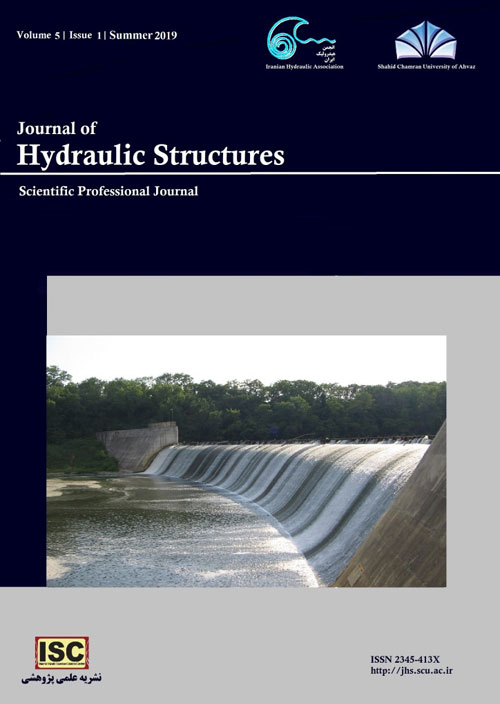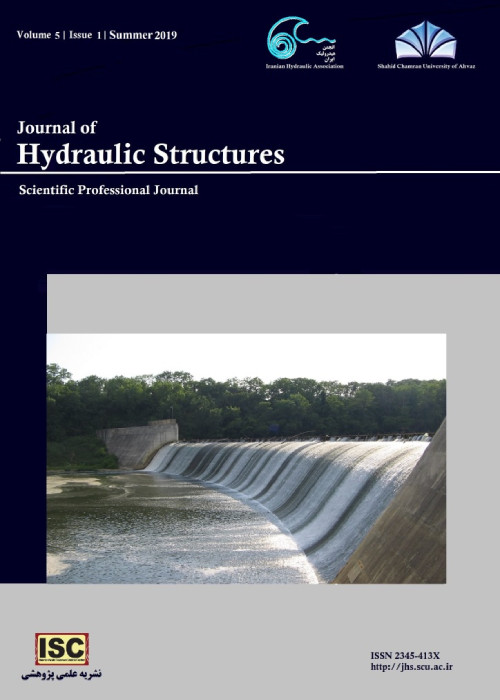فهرست مطالب

Journal of Hydraulic Structures
Volume:7 Issue: 2, Summer 2021
- تاریخ انتشار: 1400/07/10
- تعداد عناوین: 5
-
-
Pages 1-21
In the present paper, the behavior of Kerman-Baghin aquifer has been investigated using the MODFLOW program and GMS 10.3 software. The piezometer data during October 2011 are applied for steady state condition of groundwater modeling. Then, the model is calibrated for 66 months for unsteady condition using observational information, and it is validated for 24 months. Finally, the results are compared with the available observed data and show acceptable accuracy in calibration and validation steps. After validating the model, the status of the aquifer is estimated for a period of 5 years. Management scenarios including 10, 20 and 30 percent reduction in groundwater abstraction as well as artificial recharge at eight selected aquifer sites have been investigated. The location of artificial recharge sites is selected based on seven parameters of land slope, distance from waterways, distance from faults, electrical conductivity, hydraulic conductivity, geology of the area and groundwater depth (thickness of unsaturated area). These parameters are combined with the index overlay method by Arc GIS 10.3 software. The results show that by continuing the current situation, the Kerman-Baghin aquifer could face an average annual deficit of more than 52 million cubic meters. It may cause various problems in the near future including abstraction water from groundwater sources and reducing water quality. The results of implementing different scenarios show that, the best scenario can be obtained by 10% reducing water withdrawal with artificial recharge in four zones 1, 2, 10 and 12.
Keywords: Numerical modeling, Groundwater, Artificial recharge, GMS, MODFLOW -
Effect of Duration on Variations in Bed Topography and Water Surface Profile in a Meandering ChannelPages 22-45
In this study, variations in water surface profile and bed topography along a meandering path were examined under different experiment durations. Although several studies have been conducted on sediment and scour in open channels, addressing temporal variations in meandering channels requires independent, merely experimental research. In this regard, a meandering laboratory flume consisting of two consecutive 180-degree bends was used in this study. The test was conducted under clear water conditions and in 6 different durations equal to 0.2, 0.4, 0.5, 0.6, 0.8, and 1 times the equilibrium time (240 minutes). Results indicated that at the downstream bend, lengthening the test time from 0.2 to 0.4, 0.5, 0.6, 0.8, and 1 times the equilibrium time added to the maximum scour by 70, 100, 115, 120, and 165%, and also increased the maximum sedimentation by 30, 25, 45, 45, and 45%, respectively. Moreover, with a comparison made between the average transversal water surface profile for 0, 120, and 240-minute duration tests, it was observed that when these transversal profiles were displaced from 45 degrees to 90, 135, and 180 degrees, the water surface at the inner bank was lowered by 2, 5, and 7% and that at the outer bank decreased by 2, 6, and 12%, respectively.
Keywords: Scour, Sediment transport, Critical Velocity, Meandering River, Open channel -
Pages 46-59
The special configuration of V- shape stepped spillways increases energy dissipation and aeration compared to the smooth spillways due to the creation of many vortices near the steps. In this research, the energy dissipation in different types of stepped spillways with various horizontal face angles has been investigated using numerical modeling. The FLUENT, was used to model the flow over V-shape stepped spillway. The k-ɛ realizable turbulence model was selected to model the turbulent flow. The numerical results were compared with the available experimental data. The results showed a reasonable agreement between two sets of data. Then the effects of horizontal face angle, roughness and the efficiency of the end sill were investigated by numerical modeling. According to the model results, as the horizontal face angle increased, the energy dissipation also increased. Furthermore, the efficiency of end sill on the stepped spillways increased the rate of energy dissipation about 2.8 to 3.99 percent because the end sill acted like a stilling basin. Moreover, the energy dissipation increased slightly about 0.9 to 1.94 percent by increasing the roughness. Also, areas of steps under the negative pressure that could create cavitation were determined to define the minimum negative pressure and its location in all of models. Finally, the simultaneous effect of several parameters was considered to increase the energy dissipation and the minimum negative pressure.
Keywords: Stepped spillway, Energy dissipation, Numerical method, Fluent software -
Pages 60-71
Urmia Lake is one of the largest saline lakes in the world, which has greatly decreased in recent years. It has created many dangers and concerns especially concerning salt dust in its arid areas. Therefore, this research aimed to investigate the relationship between vegetation and dust in the cities around Lake Urmia. For this purpose, first, using MODIS images and NDVI index, changes in the vegetation of the region in 2010 to 2020 were determined, and then, using the MERRA-2 database, the dust concentration was extracted for the mentioned years. The results showed that the mean NDVI in the study area follows a steady trend with a total mean of 0.2957 and sometimes increases or decreases due to the influence of external factors such as dust. Accordingly, the highest rate (0.3495) of the average NDVI is related to 2018 and the lowest rate (0.2579) is related to 2013. Furthermore, to investigate the relationship between vegetation and dust, two methods of linear and logarithmic regression were used. Based on linear regression (0.7703) and logarithmic (0.7153), the findings showed that the highest determination coefficient between the two indicators was in May.
Keywords: Salt Dust, Vegetation, Modis, MERRA-2, Lake Urmia -
Pages 72-99Evaluation of Solid-Fluid interaction is of high significance in all engineering fields. In this paper, the Smoothed Particle Hydrodynamics (SPH) and the Discrete Element Method (DEM) were employed to simulate solids and fluids, respectively. As for the simulation of water behavior, first, a single-phase “dam break” experiment is modeled by the SPH. In this model, variable smoothing length and an almost novel boundary method were utilized which resulted in a tremendous boost in its resemblance to the experiment. To couple these methods (SPH and DEM), three approaches were proposed and validated against a famous experimental test named “dam break with an elastic gate test”. Finally, to be sure of the correctness of these approaches, an elastic plate under a water column in the hydrostatic condition was simulated and the error was 2 percent in comparison with the analytical solution. In pursuit of having short run-times, parallel computing on GPU (CUDA) was employed, and a robust nearest neighbor search (NNS) algorithm was modified and developed.Keywords: Discrete Element Method (DEM), Smoothed Particle Hydrodynamics (SPH), Fluid-Structure Interaction (FSI), Nearest Neighbor Search (NNS) algorithm, Parallel computing with GPU (CUDA)


